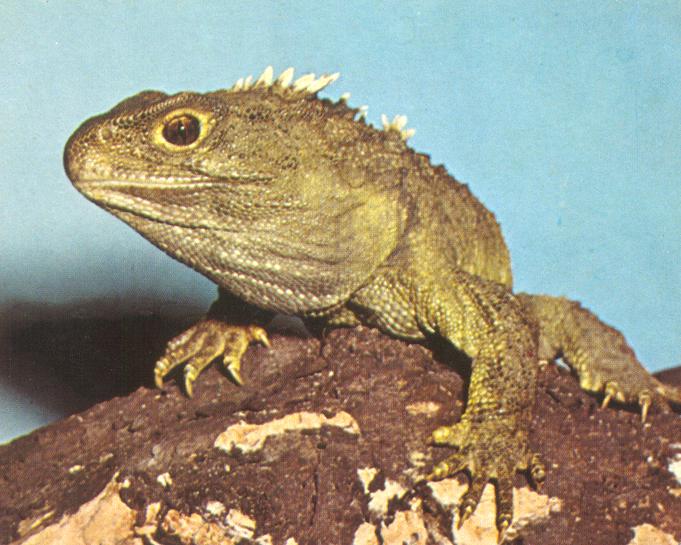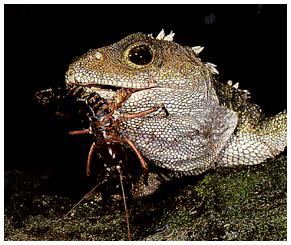The Tuatara
A living fossil
(yes, I do know that's totally cliche, but it's true!)

Sphenodon punctatus

 The tuatara is a very odd creature, as reptiles go. It looks like a cross between an iguana and a goana, but it's got a lot of other odd characteristics. First and most noticeable are the large, bony ridges over the eyes. No other lizard alive possesses these. The second is its lack of ears. The third is their teeth: they don't really have any. There are two rows in the top jaw, and one on the bottom. The bottom row meshes neatly with the top. These "teeth" are merely serrations in the jaw. They have no roots, and do not grow back when broken.
The tuatara is a very odd creature, as reptiles go. It looks like a cross between an iguana and a goana, but it's got a lot of other odd characteristics. First and most noticeable are the large, bony ridges over the eyes. No other lizard alive possesses these. The second is its lack of ears. The third is their teeth: they don't really have any. There are two rows in the top jaw, and one on the bottom. The bottom row meshes neatly with the top. These "teeth" are merely serrations in the jaw. They have no roots, and do not grow back when broken.
For the fourth, I'll have to ask you to brace yourself, because when I first read this, I doubted the very existence of the tuatara. It's another trait that no living animal posesses: a third eye! It's a very rudimentary eye, with a crude lens and retina, and it's situated under the scales on top of its head, so it can't really see anything with it. It might be a simple light sensor, to allow it to "see" when it's in strong enough light to bask, but you'd think it could do that with its regular eyes, wouldn't you? My theory is that, because of the ridges over its eyes, it can only see what's in front of or beside it, but not above it. This "pineal" eye might enable it to sense a shadow thrown across it.
The final thing that I find odd about the tuatara as a reptile is its preferred range of temperature. It prefers temperatures below 40 degrees Fahrenheit, and operates quite well in sub-freezing temps. This is odd, because most reptiles go into hibernation at temperatures like that. But the tuatara thrives, and even suffers at higher temperatures. The tuatara has a very slow metabolism, and goes about life carefully and meticulously.
The tuatara, as is the case with many species Down Under, is currently being threatened by introduced species such as rats. Organizations like Mount Bruce National Wildlife Center are conducting captive breeding programs, hatching young tuatara in captivity and releasing them onto islands which have been cleansed of all disruptive introduced species. The tuatara is currently on the Conservation Hot List.